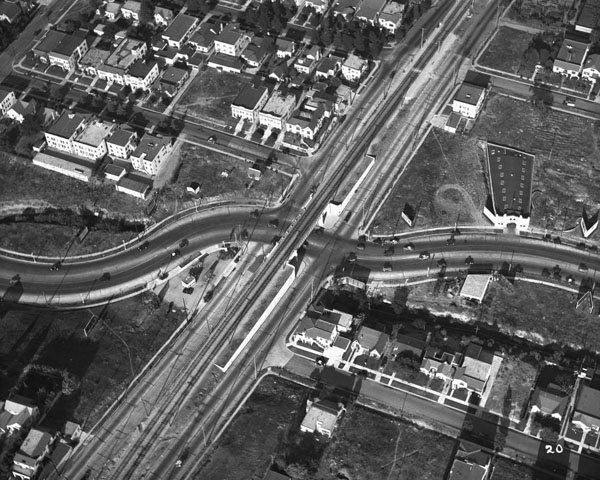Pacific Electric’s Santa Monica via Beverly Hills / Sawtelle Line: An Ill-Timed Abandonment
By Ralph Cantos
By the mid 1930s, the Pacific Electric was operating a fleet of more than 500 rail cars. The newest of them, the 100s, had just arrived from St. Louis Car Company in 1930; all 160 Hollywood cars were in service; and the PCCs and the Blimps had yet to appear on the local scene. As of 1935, the PE still had more than 200 wood/steel interurbans on its roster in 3 classes: the 800s, the 950s and the 1000s.
It was around 1935 when the PE came under enormous pressure from various “Regulatory Agencies” to make very substantial and expensive changes to its day-to-day operations. Chief among the “changes” being demanded on the PE was to rid the streets and suburbs of Southern California of “antiquated” interurbans that was tarnishing the modern, progressive image of Los Angeles, such as it was. The PE was told to have all wood-bodied interurbans off the streets of SoCal by last days of 1939. The LARY was not overlooked either, but was doing its part by placing in service 95 PCCs with more promised as funds became available.
So as 1938 dawned, the mighty 800-class interurbans were doomed, as they were the oldest of the 3 wood-bodied cars still in service. In those days of yesteryear, the PE had a tendency to assign certain cars to certain lines. Hence, if a line was to be abandoned, the interurbans assigned to that line went down the “tubes” with it.
Such was the case of the Santa Monica via Beverly Hills / Sawtelle Line, the subject of these two photos taken in July of 1940. The mainstay of the line were the fast, heavy 800-class cars with 950s supplementing the lighter off-peak schedules. Even as late as 1938, the line still was a good performer, with well over 2.2 million passengers enjoying the fast, “breezy” interurban trips to the beach.
The PE abandoned the line on July 7, 1940. Even as the abandonment notices appeared at stops along the line, passengers briefly enjoyed the the comfort of a handful of “modernized” Hollywood cars that rolled along the line in its last days of operation. PE had saved the “best for last.” Had the line lasted for just another 17 months, the demands of World War II would have most likely kept the entire line in service, at least until 1946 and perhaps longer.
In the first image (above) from the Craig Rasmussen collection, a two-car afternoon rush hour train of 800s blast over La Brea Avenue at the western end of the “PICO-SAN VICENTE Viaduct”, as abandonment neared.
The second image (below) from the City of Los Angeles Public Works Department, shows the same location from the air.
After the 1940 abandonment of the through service to Santa Monica, this portion of the line remained in passenger service as the “San Vicente Shuttle” to Genesee Avenue, one block east of Olympic Blvd. Beyond Olympic Blvd, the line was single tracked and used for “back door” movements into and out of West Hollywood Car House via the “Sherman Cut-off” until early 1951 when the Venice Short Line was abandoned on 9-17-1950, leaving the historic Santa Monica Air Line as the only passenger rail service in this part of West LA. for the next 3 years.
As for the Pico-San Vicente viaduct, its service life was over after just 23 years. It would remain standing another 14 years until 1964, when it was bulldozed away, leaving no trace that it ever existed.




As a society we were all so short sighted regarding the value of public transportation during those years. I remember my dad getting mad a being stuck behind a trolley downtown and point was, we should have been on that streetcar instead of in our car. Shame the collective “we” let it all happen. One of the high points in my transit career was being one of the many agency guys involved in the many part of the construction of the Blue Line. . . with the extensions of rail in the SCAG area, maybe we can make up for a little of what we lost. Great article, and right on point.
The “squiggly” street pictured in the second image above is La Brea Ave., prior to its straightening for the cause of traffic flow. Looks much nicer with those curves, in my opinion.
The curve is still the same, and it was never straightened. Only the bridge was bulldozed. The photo shows La Brea at San Vicente before the bulldozer. I recall my dad telling me how he used to stash stuff under the bridge back in the 40’s and 50’s. Now, there’s just a lot more buildings. I have photos of the area as it was being developed..
Hi,
I believe that the fifth picture from the top is Santa Monica and Beverly Glen. Not Venice and Robertson.
Thanks for the historical perspective on the Beverly Hills line. Interesting the brief moment of just two years that separated the line’s more or less four decades of regular service and the perceived benefit of abandonment. Just ridiculous.
I’m interested in seeing the old right-of-way in City of Beverly Hills (a handful of parcels now privately owned, some primed for development) turned into a rails-to-trail between West Hollywood and Century City. This would honor the corridor’s long history of multimodal mobility while enabling active mobility for the coming generations.
GOOD LUCK WITH THAT !!!
To Mark Elliot: wow that would bring back some memories. Unfortunately, as you say, that would involve re-acquiring some privately owned parcels, demolishing a few parking garages along the south side of North SM Blvd. and of course getting Beverly Hills homeowners to agree to it – which is more difficult than anything. I still remember as a kid seeing one of the last So. Pac. trains crawling down SM Blvd – probably to Fisher lumber. If your dream comes true and the rails kept going west, I wonder if they’d build another bridge over the Beverly Glen intersection. Does anyone remember when the old bridge was removed? It wasn’t soon enough for Ernie Kovacs to finish making his left turn…
Mark I just realized you didn’t mean the reinstallation of a railroad, just a hiking trail… but I want the RR back 🙂
Today
https://maps.google.com/maps?q=west+Pico+Boulevard,+Santa+Monica,+CA,+United+States&hl=en&ll=34.050393,-118.344834&spn=0.000661,0.000871&sll=34.032941,-118.440557&sspn=0.014955,0.027874&hnear=Pico+Blvd,+Santa+Monica,+California&t=k&z=21&layer=c&cbll=34.050391,-118.344962&panoid=JvMdnyHy_W3PE3GwUTTM_w&cbp=12,113.93,,0,-9.86